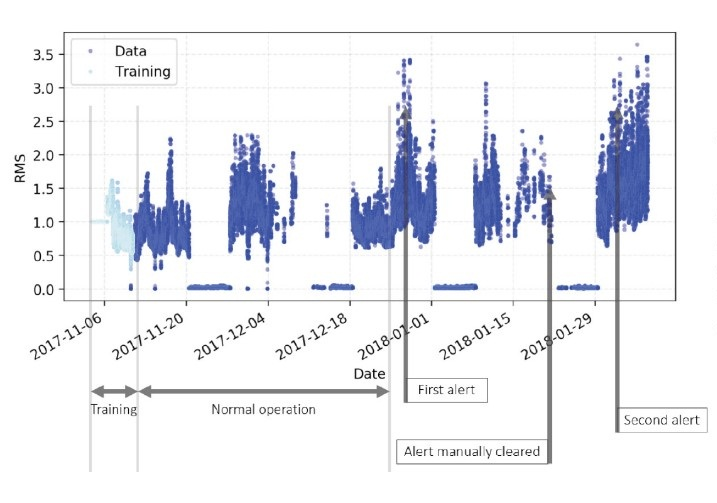Historically, the use of condition monitoring solutions for predictive maintenance has been restricted to high-value, mission-critical equipment, leaving an average of 85% of a production facility’s equipment vulnerable to costly unexpected downtime and repairs.
The problem with today’s solutions, says Brad M. Hopkins, director of Condition Monitoring Product Management with HID Global, is that they either are not aligned well with plant requirements or they are considered prohibitively expensive to deploy facility-wide.
Now, a new class of condition monitoring solutions combines low-cost, low-power Internet of Things (IoT) technology with Artificial Intelligence (AI)-driven cloud analytics to reduce the cost and deployment complexity of predictive maintenance across an entire asset fleet.
The high cost of failure
Although motors are generally categorised as critical/expensive, semi-critical, or part of the “balance of plant” (BoP), the reality is that all equipment is operationally critical. Regardless of which category of equipment fails and causes downtime, the associated hourly costs can potentially range from US$30,000 in food processing plants to $87,000 in the petrochemical industry and as high as $200,000 at an automotive factory.
Failures may also generate other labour and equipment repair and replacement costs across asset fleets of hundreds or thousands of BoP motors. There are also the costs of plant production losses to consider when failures impact timelines and production service-level agreements (SLAs) or extend backlogs.
These risks can be mitigated using IoT-based condition monitoring solutions that integrate low-cost, low-powered sensors into a wireless communication platform with AI-driven cloud analytics capabilities. This approach reduces the cost and deployment barriers to moving maintenance from a reactive or preventive approach to a more knowledge-based and predictive approach spanning the entire production line.
A new condition-monitoring
Deployment Model
Today’s IoT-based, AI-driven solutions employ low-cost sensors that are easy to install, making it economically feasible to use condition monitoring across the production line’s full range of assets including BoP motors. The solutions use algorithms and data analytics to help determine asset health and predict problems or failures, and they take advantage of powerful policy engines to identify and warn users about imminent issues in real time.
Unlike traditional condition monitoring solutions, IoT-based offerings require no wired infrastructure, servers or antennas, and are easier to integrate into a plant manager’s inspections, maintenance, and operations practices across multiple asset fleets. Bluetooth Low Energy (BLE) beacons with vibration and temperature sensors are installed on each asset and used for on/off detection and real-time monitoring of duty cycles, temperature, and vibration.
The beacons use edge processing to calculate machine health metrics to help reduce the amount of data transmitted through a Bluetooth-to-WiFi gateway to the cloud, where further analysis occurs. This also allows for more frequent data collection, providing near real-time visibility into machine vibration state with new data every two minutes.
After an initial training period to learn baseline vibration behaviour for each asset on which a beacon is installed, the solution generates models of normal activity. It then uses a policy engine to identify significant deviations from this baseline and notify organisations of these changes to help them take steps for reducing downtime. From this point on, plant management has a critical tool for improving proactive maintenance, inspection, and operation strategies and make better decisions about what actions to take.
These predictive maintenance enablement tools are delivered via cloud-based software-as-a-service (SaaS) subscriptions. This gives organisations greater flexibility to deploy the capabilities they need, when they need them — from basic fleet management for remote hardware configuration through more in-depth equipment status monitoring up to a full range of advanced condition monitoring including fault detection for AI-based alerting.
Early Successes
Manufacturers in multiple industries are realising valuable benefits from adopting IoT-based condition monitoring solutions using AI-driven cloud analytics. As an example, one of the world’s largest steel manufacturers is monitoring motor temperature and vibration in a 70 to 80 degrees Celsius environment to enhance their predictive maintenance strategy and reduce unplanned equipment downtime throughout the plant.
These solutions often find problems that are missed during inspection.
A leading pharmaceutical manufacturer was alerted to such an issue, which was placed under observation since it could not be validated visually (see Fig. 1). The alert was re-triggered within a week, leading to a thorough check with high-bandwidth, lab-grade instrumentation and advanced data processing. Degradation was confirmed, and the plant made the necessary repairs to avert expensive unplanned downtime.

Traditionally, plants have not deployed condition monitoring solutions on equipment other than the most expensive or mission-critical. Now, with this new increased visibility all the way down the production line, organisations can thwart unplanned downtime and unexpected repairs, equipment replacement, and associated labour requirements related to the bulk of their fleet.
By combining Bluetooth beacons with a cloud-based AI-driven analytics engine, the latest solutions address these challenges in a very different manner than in the past. They give organisations a quick and easy way to gather and monitor the actionable data they need for plant-wide predictive maintenance programs and smarter overall operations.
The author is Brad M. Hopkins, director of Condition Monitoring Product Management with HID Global.
Comment on this article below or via Twitter: @IoTNow_OR @jcIoTnow










